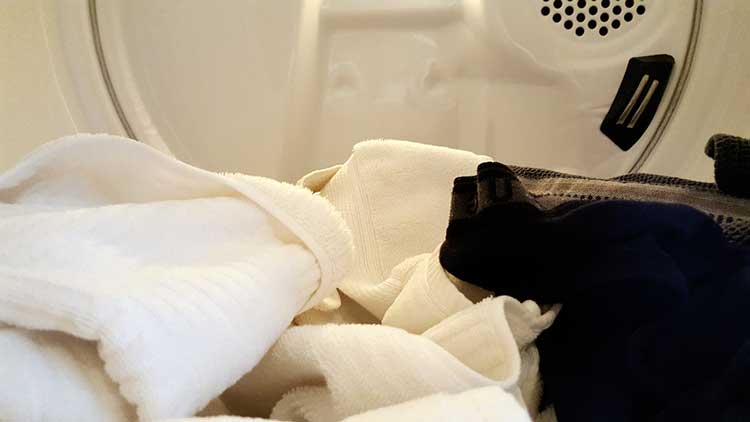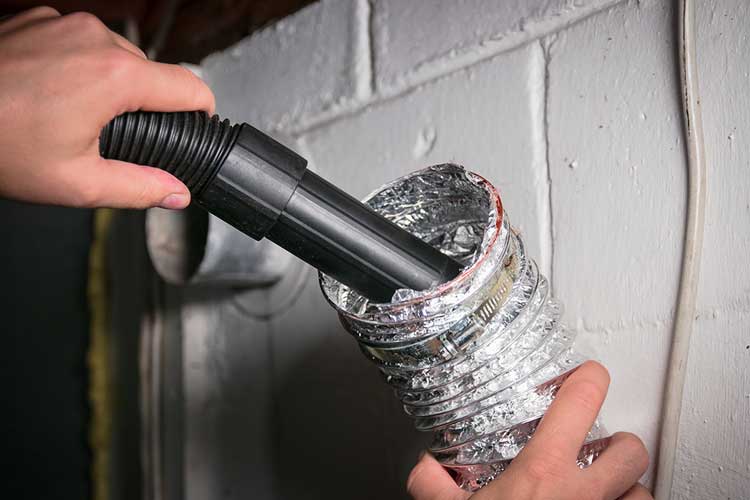Last updated June 5, 2025

If you clean out your clothes dryer’s lint trap after every load, give yourself a high five; doing so improves the appliance’s efficiency.
But many consumers don’t realize that the dryer duct, which vents hot air outside your home, also needs to be cleaned out periodically. The National Fire Protection Association estimates that clogged traps and vents may contribute to the more than 13,800 U.S. home structure fires that occur each year due to clothes-dryer mishaps.
It’s an out-of-sight, out-of-mind issue, said Kevin Feak, a fire-protection engineer and former fire inspector and firefighter in the Syracuse, N.Y., area. When combustible lint starts to accumulate and restrict air flow, your dryer must work harder. This might make the appliance overheat and ignite a fire, either in the appliance itself or within the vent. “When I was a firefighter, we were called to a dryer-caused fire at least once a month,” he said. “Reducing this build-up of combustible lint will help mitigate the fire risk.”
Also, a clogged vent makes the dryer work harder to push the air through the blocked dryer vent, causing higher energy bills as well as wear and tear on your machine, said Sydney Sims, a consumer advocate at Ownerly, a home valuation company. If your clothes take longer than usual to dry or feel hot to the touch when you pull them out, those are signs that your dryer duct is clogged, she said.
Most experts recommend you clean your dryer vent once a year. If you have a big household or dry heavy fabrics like towels and bedding often, it should be done twice annually, said Sims.
While you can hire a professional dryer vent cleaning company, you don’t need to.
With the right tools, most homeowners can do the job themselves. A dryer vent cleaning kit with brushes and flexible extension poles can be found online or at home improvement stores for $20 to $30.

To clean your dryer vent, follow these steps:
- Unplug your dryer. If you have a gas model, shut off the valve and disconnect the supply line.
- Slide the appliance out far enough from the wall to create a workspace.
- Have a vacuum or broom and dustpan nearby to help keep the mess to a minimum.
- Disconnect the vent ductwork.
- Feed the cleaning kit’s brush into the vent system, pulling and turning it (think of it as a huge bottle brush) every few feet until you reach the end.
- As you pull out the brush, any trapped lint and fiber will be stuck to the bristles; vacuum off that stuff as you go so the brush remains clean.
If you can’t slide your dryer far enough out from the wall to create a workspace behind it, go outside and clean out the duct from there. Remove the exhaust cover, use the brushes as directed above, and then verify the vent is clear by using a flashlight to look inside.
If you don’t want to do the work yourself—or teeter on a ladder to do it from outside your home—then you can hire a pro. Most charge about $100 to $200 and may bring additional equipment such as an air compressor to blow out excess residue. Ask for firm prices in advance.
Many dryer-vent cleaning operations also clean HVAC ductwork. As Consumers’ Checkbook has warned in previous reports, despite what they may tell you, most homeowners don’t need HVAC duct-cleaning services.
Sims points out that there are plenty of good step-by-step dryer vent cleaning videos on YouTube. Those who aren’t comfortable with DIY, but want to save money, might hire a handyman or duct cleaning pro for one initial cleaning. “Watch what they do and ask questions; then get a kit and do it on your own in the future,” she said.
We tried it. I hadn’t had my own dryer vent cleaned since moving into my home more than 20 years ago. My laundry room is tight, making it impossible for me to pull out the dryer myself and access the vent from the inside. I didn’t want to pay $97 for someone to clean my four feet of duct work, so I chose the outside option. While writing this story, I ordered a cleaning kit from Amazon and watched a short YouTube video.
I found the process relatively easy. I snapped together the kit’s brush and flexible rods, then attached the rod end to a portable drill. This meant I didn’t have to rotate the brush manually. Then, I inserted the brush through the vent outside my house until it would go no further.
I then pulsed the drill and pulled it back out a few times until the brush was no longer covered in lint—about 10 minutes in total.
I know the process worked because my laundry drying times have dropped dramatically.
One tip: If you have a Shop-Vac or similar high-performance vacuum and only a short span of duct work, you can also push the flexible vacuum hose (don’t use an attachment) into the duct work to suction out excess lint.


